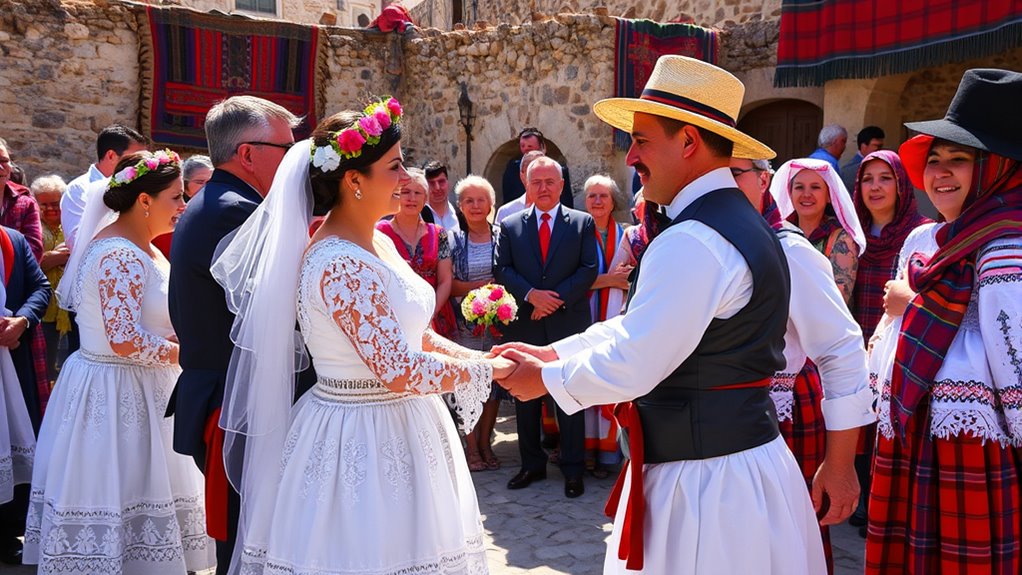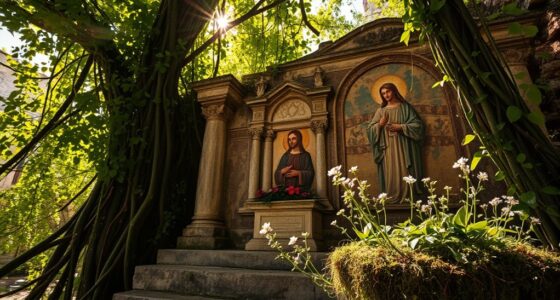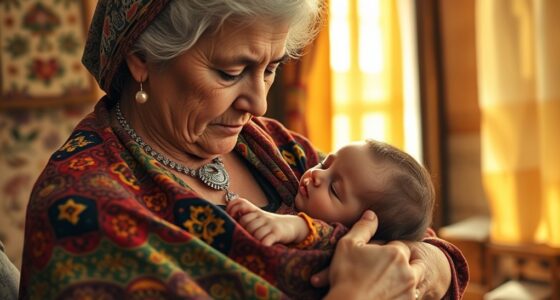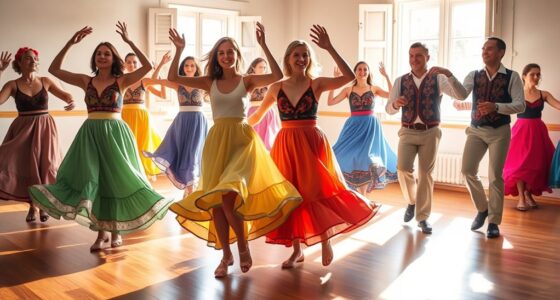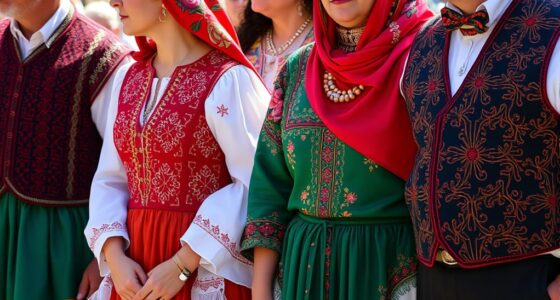In a traditional Sardinian wedding, you’ll see vibrant customs like elaborate attire with silk and embroidery, symbolic rituals like exchanging rings and releasing doves, and the breaking of a plate called Sa ‘Ratzia’ to symbolize a fresh start. Community involvement shines through lively processions, folk music, and decorated carts. Key objects, like the Fede Sarda ring and sa Cadena chain, represent unity and protection. If you continue exploring, you’ll discover even more fascinating details about this timeless celebration.
Key Takeaways
- Wedding attire features elaborate silk, velvet, and embroidery for the bride, and simple black wool for the groom.
- Rituals include processions with traditional music, blessing rituals, and symbolic exchanges like rings and sa Cadena.
- The breaking of the plate by the bride’s and groom’s mothers signifies releasing the past and welcoming prosperity.
- Community participation involves lively processions, decorated carts, folk music, dance, and collective celebration.
- Symbolic objects such as fede sarda rings and sa Cadena represent eternal love, protection, and community bonds.
The Traditional Attire and Dressing Customs

In Sardinian weddings, the traditional attire plays an essential role in showcasing regional identity and cultural pride. You’ll notice the bride’s gown made of precious fabrics like silk satin, velvet, brocade, and fine linen, reflecting wealth and craftsmanship. Embroidery with colorful floral motifs decorates her dress, symbolizing fertility and prosperity. She often wears jewelry such as filigree pieces, a wedding chain called sa Cadena, and decorative hairpieces, highlighting regional artistry. The groom’s outfit contrasts with an austere look, dressed in black orbace wool, a coarse fabric unique to Sardinia, with simple accessories. The elaborate dressing process can take weeks, with family present for the ritual, emphasizing the importance of tradition and cultural heritage in every detail of the attire. Additionally, the traditional attire often incorporates specific regional symbols and motifs that are passed down through generations, further emphasizing cultural identity.
Rituals and Symbols During the Religious Ceremony

The religious ceremony in Sardinian weddings is rich with rituals and symbols that reinforce community bonds and spiritual devotion. You’ll notice the procession, where the bride and groom, dressed in traditional attire, are accompanied by musicians playing launeddas and tumbarinos, symbolizing cultural continuity. The groom arrives with friends in a decorated wagon, serenading the bride at her home before heading to church, emphasizing community participation. Inside, the ceremony is conducted in Sardinian Campidanese dialect, with prayers and blessings that deepen spiritual connections. The exchange of rings signifies commitment, while sa Cadena, a silver chain, symbolizes eternal union and interconnectedness. As the couple exits, doves are released for peace, and blessings of water and rice-filled dishes symbolize prosperity and fertility. These rituals often include traditional songs and local prayers, further enhancing the spiritual atmosphere of the celebration. Additionally, the use of vintage and retro styles in wedding attire reflects a respect for tradition while embracing contemporary influences.
The Breaking of the Plate: Sa ‘Ratzia and Its Significance
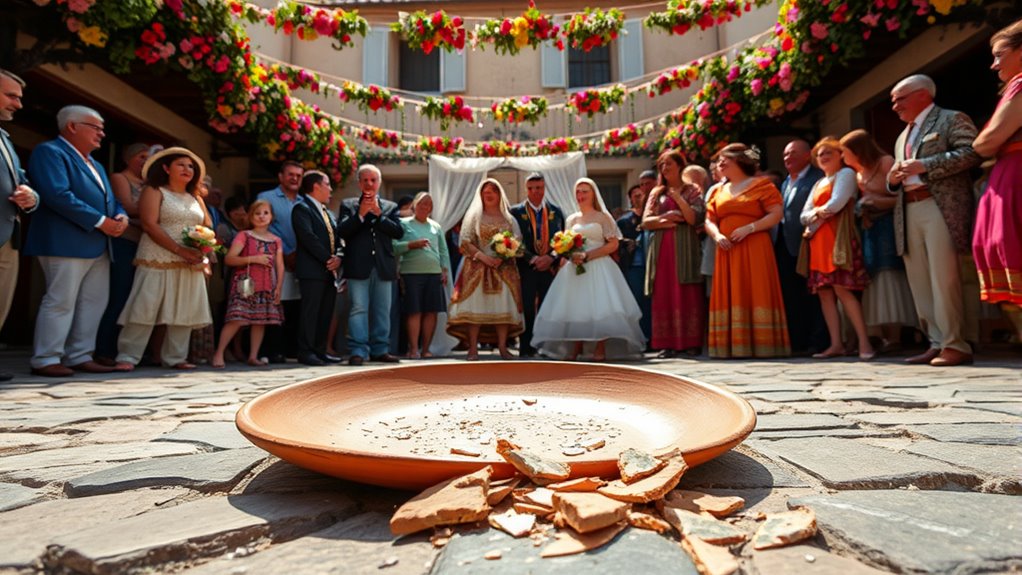
Among the many meaningful customs that mark Sardinian weddings, the ritual known as Sa ‘Ratzia stands out for its symbolic power. In this tradition, the bride’s and groom’s mothers break a new, whole plate at their feet, usually during the reception or right after the ceremony. The plate is filled with rice, wheat, salt, candies, almonds, coins, and flower petals, each representing virtues like fertility, prosperity, and purity. When the plate shatters into many pieces, it symbolizes breaking away from the past and welcoming a new life together. The loud crack signifies strength, unity, and the couple’s readiness to face the future. Sa ‘Ratzia remains a cherished ritual, embodying blessings, community support, and hope for happiness and abundance. The act of breaking the plate is often performed by a close relative, such as the bride’s mother, emphasizing the family’s blessing and involvement in the couple’s new journey.
Processions, Celebrations, and Community Participation
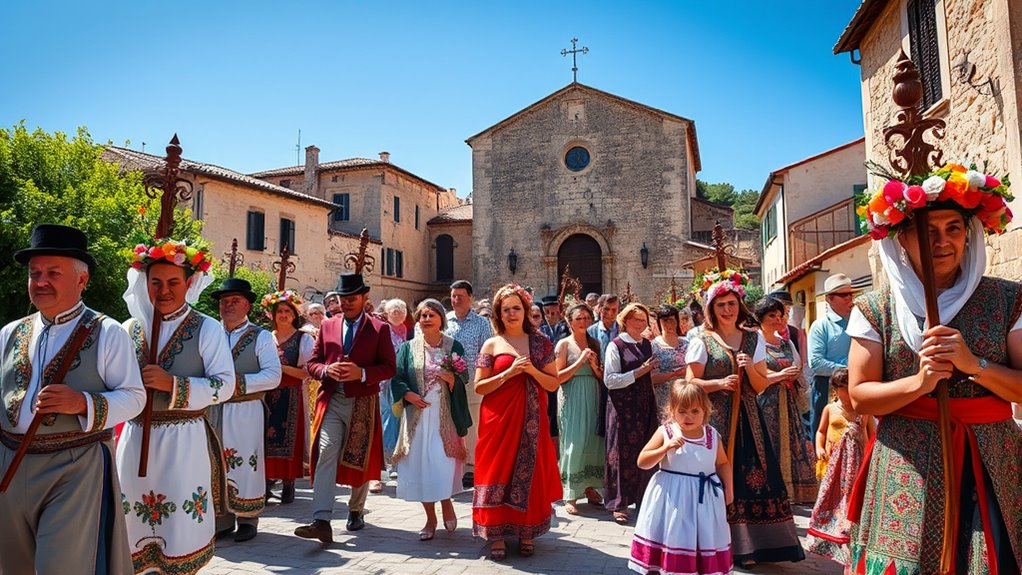
Wedding processions in Sardinia are lively, community-driven events that move slowly through historic streets, creating a festive atmosphere filled with tradition. You’ll see knights and musicians playing launeddas and tumbarinos, setting an energetic tone. The groom’s procession often features a decorated cart with young people serenading the bride from her home. Family members, especially women, watch from windows as men sing polyphonic courtship chants. The bride’s dowry chest is carried on ox carts decorated with tapestries, vines, wheat, and flowers, reflecting the community’s agrarian roots. Folk groups from across Sardinia join the festivities, emphasizing the communal spirit. Entire villages gather to celebrate, contributing carts, music, and food, making the wedding a collective celebration of unity and cultural pride. Additionally, traditional GMC tuning techniques are sometimes incorporated to enhance the sound of local music instruments, highlighting the blend of modern innovation with age-old customs.
The Meaning Behind Symbolic Objects and Family Roles
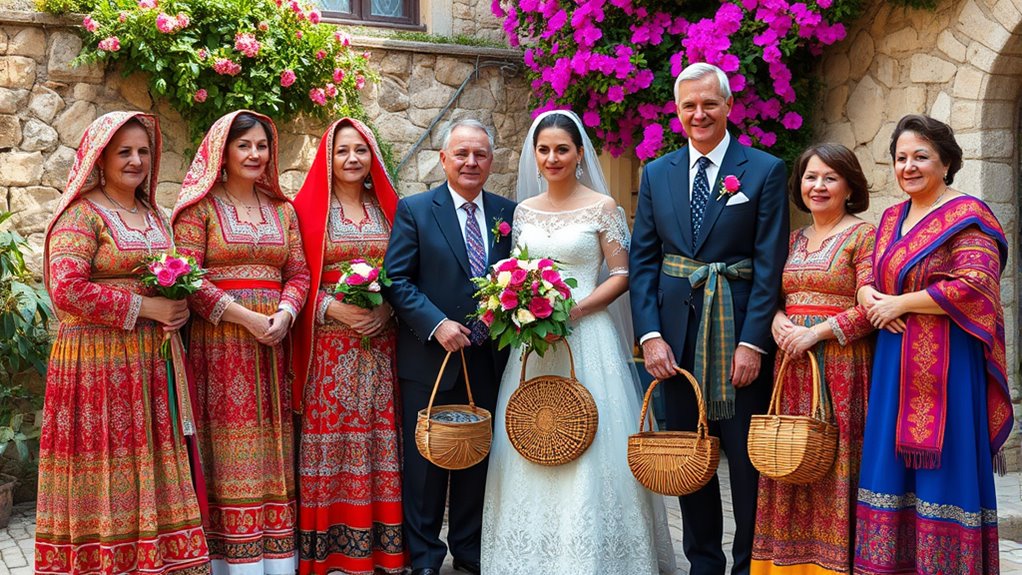
As families come together to celebrate Sardinian weddings, they also pass down a rich array of symbolic objects that embody deeper meanings. The *Fede Sarda* wedding ring symbolizes love, prosperity, and protection, with mythological roots tied to the island’s fairies, the Janas, believed to grant magical powers. The *Sa Cadena*, a chain of 66 silver rings, represents eternal faith and community bonds. Rings like the *maninfide*, with clasped hands, signify trust and union, traditionally exchanged with a knife featuring engraved handles, reflecting reciprocal commitment. These symbolic objects are often crafted with intricate filigree techniques, highlighting Sardinia’s artisanal craftsmanship. The use of symbolic objects in wedding rituals emphasizes the importance of cultural identity and tradition. Family roles are crucial: elder women pass down heirlooms, fathers offer symbols of protection, and collective efforts organize rituals, reinforcing the wedding’s significance as a community and cultural celebration.
Frequently Asked Questions
How Do Sardinian Wedding Customs Vary Across Different Regions?
You’ll notice that Sardinian wedding customs differ across regions. In Campidanese areas, expect lively processions, ox carts, and symbolic chains, while Gallura features lively car convoys, dish-smashing, and coastal celebrations. Inland, traditional attire, local cuisine, and folk dances dominate, emphasizing cultural roots. Coastal towns offer scenic outdoor venues with sea views and elegant ceremonies. Each region celebrates unique customs, blending history, music, and community spirit into memorable, distinct festivities.
What Is the Significance of Polyphonic Singing in Sardinian Weddings?
Imagine stepping into a time capsule—polyphonic singing in Sardinian weddings is essential because it celebrates community, tradition, and unity. You see, this ancient vocal art embodies collective identity, blessing the couple with harmony and cooperation. It connects guests to ancestral roots, reinforcing social bonds. Even amid modern changes, preserving this singing style keeps the cultural spirit alive, transforming weddings into powerful rituals that honor Sardinia’s rich, enduring heritage.
Are There Modern Adaptations to Traditional Sardinian Wedding Rituals?
You’ll notice that modern Sardinian wedding rituals blend tradition with contemporary touches. Couples might wear a mix of traditional and modern attire, incorporating jewelry and accessories, or adapt rituals like serenading or dowry presentations to fit schedules. Venues are decorated with modern lighting and floral arrangements, and technology plays a role in coordination. These adaptations honor Sardinian heritage while making the celebration more practical and enjoyable for today’s couples and guests.
How Do Community Members Participate in Wedding Celebrations Today?
You might think today’s wedding guests just show up, snap photos, and leave, but in Sardinia, community members are still deeply involved. They sing ancestral songs, wear traditional clothes, and contribute handcrafted decorations. You’ll see elders passing down stories, friends joining in dances, and everyone sharing meals. Modern planners blend old customs with new trends, keeping the community’s spirit alive—proof that tradition still thrives, even with a trendy twist.
What Are the Origins of the Sa ‘Ratzia Ritual?
You’re curious about the origins of the sa ‘ratzia ritual. This ancient Sardinian custom dates back centuries, rooted in the desire to bless newlyweds with good fortune, fertility, and prosperity. Traditionally performed by the mothers of the bride and groom, it involves breaking a new plate filled with symbolic items. The act marks a fresh start, warding off bad luck and emphasizing family involvement in welcoming the couple into married life.
Conclusion
As you witness these timeless customs, remember that each symbol and ritual is a thread woven into Sardinia’s rich fabric of tradition. The broken plate, the ornate attire, and the lively processions all represent unity, hope, and the deep bonds of family and community. By embracing these rituals, you carry forward a legacy that transforms a simple wedding into a sacred tapestry of identity and belonging, forever connecting past and future in a dance of enduring tradition.
